Why do honeysuckle leaves turn yellow in June and how to fix it
Beautiful and unpretentious honeysuckle bushes sometimes begin to turn yellow and shed their leaves. There are many factors that trigger summer leaf fall. It is important to correctly determine why honeysuckle turns yellow and withers, since not only the appearance of the plant, but also the safety of the crop depends on further actions.
Why do honeysuckle leaves turn yellow in summer?
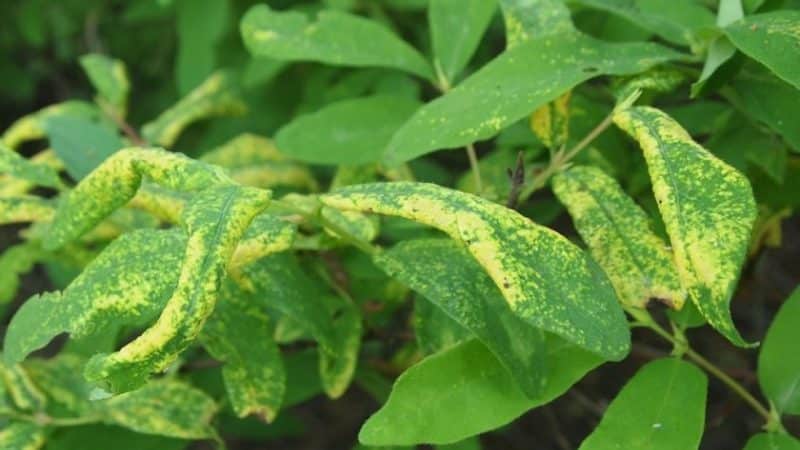
Along with other garden crops, such as gooseberries, currants and raspberries, gardeners grow honeysuckle. The plant requires little care, bears fruit well, and produces tasty and healthy berries. Honeysuckle also serves as an ornamental plant, decorating the area with amazing greenery.
An alarming sign for any gardener if honeysuckle leaves turn yellow untimely. What to do to save the plant and the harvest? First of all, it is important to determine why the leaves are drying.
Main reasons:
- violation of the rules of agricultural technology or planting;
- deficiency of nutrients in the soil;
- overmoistening of the root system or insufficient watering;
- the appearance of pests or diseases.
Moisture-absorbing sandy and loamy soils are suitable for planting. It is recommended to avoid overly dry or waterlogged areas. It is important to pay attention to the acidity of the soil: at high levels, honeysuckle grows poorly, so add lime before planting.
For reference. The permissible distance between plants when planting is at least 1 m, otherwise the bushes will oppress each other.
The shadow is the enemy of culture. In summer cottages, it is better to plant plants in an open place, but under the protection of trees or larger shrubs that provide slight shading.
What to do if honeysuckle leaves turn yellow and dry
First of all, it is important to determine the causes of deformation of sheet plates, and only then - to take measures to eliminate them.
How to water
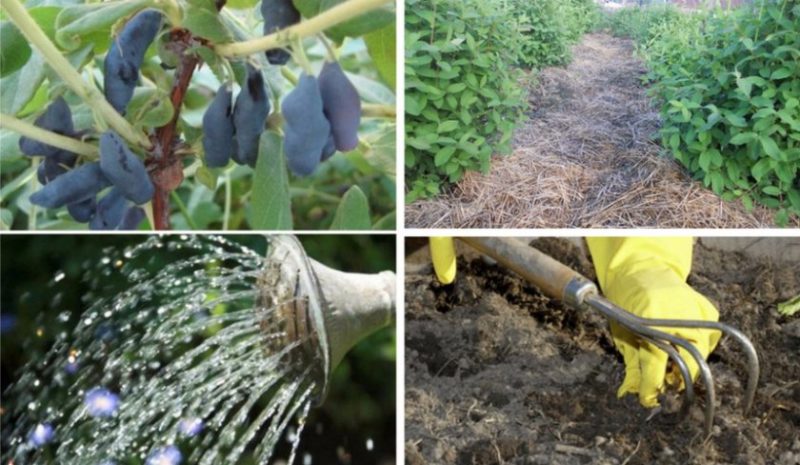
Honeysuckle loves moderate watering. Depending on the period - dry or rainy - irrigation rules differ. In systematically rainy weather, 3-4 waterings during the growing season are sufficient. 1 bucket of water is poured under each plant. During drought and in late spring and early summer, honeysuckle is moistened more abundantly. If the plant does not have enough moisture, this will affect the quality of the harvest: the berries will become bitter.
It is better to moisten the soil in the evening, thereby preventing moisture evaporation. After watering or rain, the soil around the plant is loosened to a depth of 7-8 cm, removing all weeds. If the soil is mulched, loosening is done less often and through mulch.
What to feed
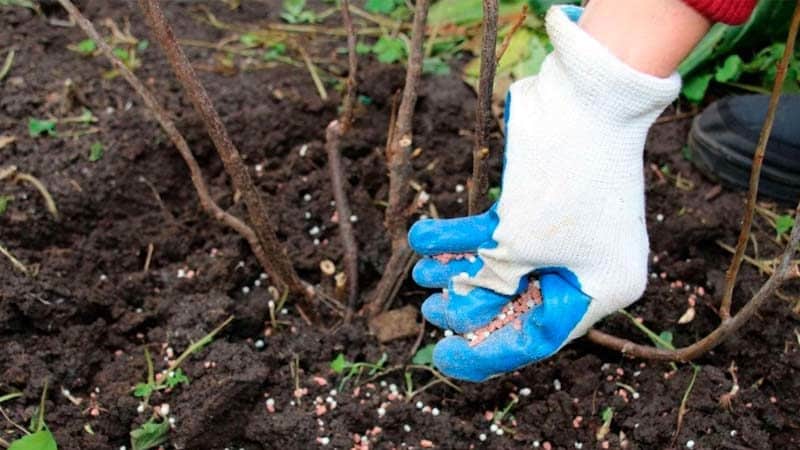
Why do honeysuckle leaves turn yellow in June? One of the reasons is the lack of fertilizers. The better the care, the better the appearance of the plant and the harvest. Young bushes (up to 2 years) do not need feeding. Old plants are fertilized once every 2 years. It is recommended to use organic formulations.
Feeding is carried out in 3 stages:
- Deep autumn. For every 1 m² of plot, add 100 g of wood ash, 40 g of double superphosphate and 5 kg of compost.
- In spring, before the buds open. Each 1 m² is fertilized with 15 g of ammonium nitrate or the plant is fed with a urea solution (1 tablespoon of product per 10 liters of water).
- After the harvest. Use a solution of nitrophoska or nitroammophoska (25–30 g per 10 liters of water), slurry (1:4) dissolved in 1 bucket of water.
Complex preparations in which microelements are in chelated form are also suitable: “Florist”, “Uniflor Micro”, “Kemira”.
Treatment for diseases
If you followed all the rules of agricultural technology, but noticed yellow spots on the leaves of honeysuckle, this is the first sign of the appearance of pests or diseases. Although honeysuckle has a strong immune system, it is susceptible to fungal diseases (powdery mildew, tuberculosis, reddish-olive spot, etc.).
All diseases have one common symptom - premature yellowing and drying of leaves, but each has distinctive symptoms.
Powdery mildew
Characteristic signs are a powdery white coating on small areas of the leaves. As the disease progresses, the affected foliage turns yellow and dries out, and new shoots become deformed. Fungicide treatment is required.
Tuberculariosis
It affects the shoots of bushes, reddish tubercles appear on them. Neighboring branches gradually become infected. Already in June, the leaves dry out, and in August the spore propagation phase is repeated on the affected stems.
Damaged parts of the bush are removed and burned. The cut sites are treated with Bordeaux mixture or copper oxychloride.
Reddish olive spot
The disease is recognized by reddish-olive spots on both sides of the leaf blade. Gradually they darken, acquiring a brown tint.
In severe cases of the disease, it is better to use fungicides. For preventive purposes, regular honeysuckle pruning and collect fallen leaves.
Cercospora
Round dots with a red-brown edge appear on the foliage.To prevent the fungus from spreading to healthy areas, the affected shoots are removed and treated with chemicals.
Mottling
Refers to viral diseases. Appears in the form of dots of varying intensity or arc-shaped spots. The development of the disease is caused by pests - nematodes.
For reference. A viral infection causes serious harm to the plant: it dries, sheds leaves, and reduces the volume of fruiting. Therefore, it is important to prevent the appearance of provoking insects.
In case of mottling, phytosanitary cleaning is required - removal and burning of affected areas and culling of diseased bushes. This is the only measure, since viral diseases are incurable. Honeysuckle is very rarely affected by them.
Rezucha mosaic virus
Spread by nematodes. It is possible for the plant to become infected through poor-quality planting material. The vital activity of the virus manifests itself in the form of shortening of internodes, awakening of axillary buds and the growth of many lateral shoots.
As a result, the plant becomes depleted, becomes smaller, the leaves become deformed and dry out. Diseased bushes are dug up and burned. The only way to resist the virus is to follow the rules of agricultural technology.
There are a sufficient number of insect control products on the market - biological products and chemicals. Each of them has its own processing time.
What to process
To prevent the appearance of diseases and pests, plants are treated before the leaves bloom and at least 20 days before active flowering. This will get rid of the problem and not cause harm to insects that pollinate the shrubs.
Repeated processing is carried out after harvesting.
Bordeaux mixture
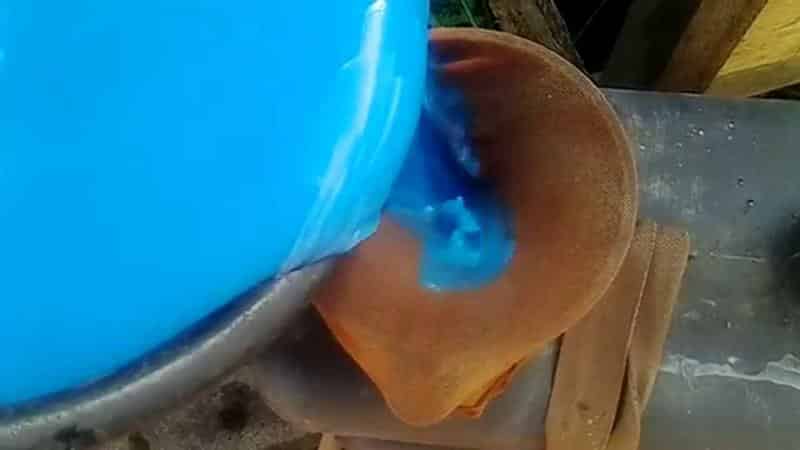
Consists of copper sulfate and calcium hydroxide.The powders are diluted in separate containers with ¼ part water, then added with water to the required volume. Stirring constantly, add lime milk concentrate into the copper sulfate solution. The product is used immediately after preparation and is not stored. Processing is carried out in 3 stages with a frequency of 25 days.
"Nitrophen"
Broad spectrum insectofungicide. It is rational to use for autumn treatment, as it remains in the soil throughout the winter. To prepare a working solution, dilute 150 g of the product in 10 liters of water. Use the composition immediately, do not store. Irrigation is carried out in dry, windless weather, early in the morning or late in the evening.
"Topaz"
Highly effective fungicide based on penconazole. It is not phytotoxic and remains in the soil for a long time. The active ingredients are quickly absorbed by plant tissues, which does not depend on weather conditions for the use of the drug. One ampoule of concentrate is diluted in 10 liters of water. During the season, 3-4 irrigations are sufficient with a frequency of 21 days.
"HOM"
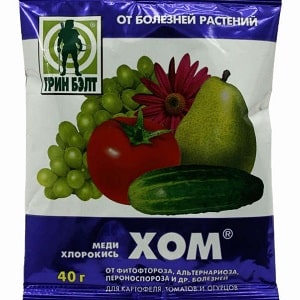
Copper oxychloride is recognized by gardeners as an excellent substitute for Bordeaux mixture. It is used in calm weather, during the period with the least chance of rain.
Important! Chemicals require precautions. For safety reasons, use only certified products, work in overalls, cover your nose and mouth with a gauze bandage.
On average, 40 g of the drug is calculated for 10 liters of water. The powder is dissolved in a small amount of liquid, then water is added to the required volume with constant stirring.
"Fitosporin-M"
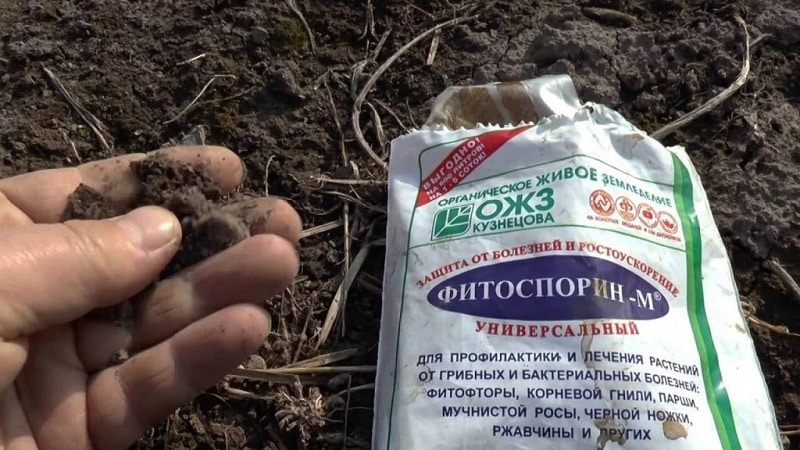
Biological preparation of systemic action based on spore culture. It is used at any stage of plant development. The product is absolutely safe for the crop, even on the day processing. Sold in powder, paste and aqueous suspension form. The plant is treated with Fitosporin only in cloudy weather or after sunset, since the product does not tolerate bright sunlight.
The powder is diluted 2 hours before treatment strictly according to the instructions. When using paste, prepare a concentrated solution, which is diluted before processing. Only boiled, melted or rain water is suitable for this. Chlorinated water from the tap is detrimental to the bacteria contained in the preparation.
For better adhesion of the product, add liquid soap to the solution. Proportions: 1 ml per 10 l.
"Trichodermin"
A harmless and safe drug does not affect the taste of the crop. The fruits are allowed to be consumed on the same day after treatment with the product. To prepare the medicine, the following proportions are followed: 10 g of the substance per 1 liter of warm water. Add the powder gradually, stirring continuously. Allow to stand for 1-2 hours at a temperature not lower than +15°C. Use the prepared solution within the first 6 hours after preparation.
Pest treatment
Even the most common insect pests can disrupt the life of a plant.
Aphid
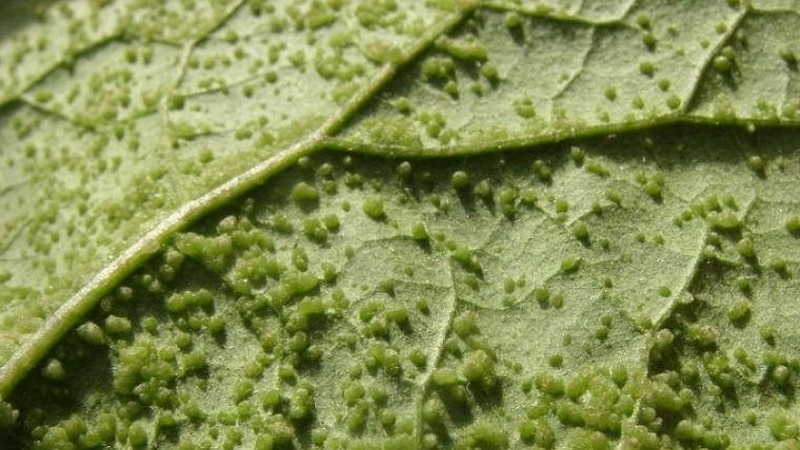
This is a small green insect. Peak pest activity occurs in spring. The first signs of an aphid invasion are deformation and curling of leaf blades. If you carefully examine the underside of the leaf, you can see small insects. As the colony grows, other parts of the plant are also affected.
For reference. Aphids not only damage the bush, but also secrete a sticky substance, which interferes with the gas exchange of the plant and provokes the development of fungal diseases.
Mechanical destruction of insects is permissible at the initial stage of infection (you can use a soap solution). The affected areas are cut off.At the same time, it is important to destroy ants that carry aphids.
Nematode
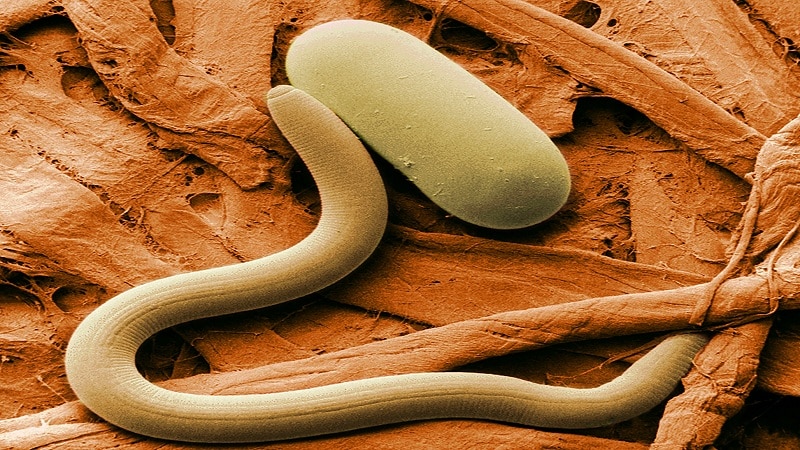
This small transparent or white worm, like other pests, prefers to feed on plant sap, but settles in the roots, which makes it difficult to identify it in a timely manner.
Shchitovka
One of the common pests of honeysuckle. An adult is recognized by its hard shell-scutellum. Pests settle on the lower part of the foliage and in places where cuttings are attached to branches. The insect prefers juice from shoots, which leads to withering of the plant and rapid loss of green mass.
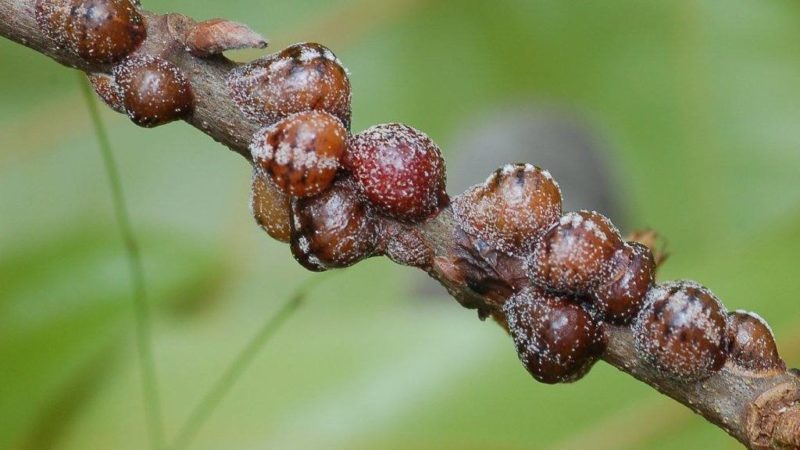
What to process
Insecticides are used to kill harmful insects. The most popular of them are presented below.
"Aktara"
The drug has a wide spectrum of action - suitable for both irrigation and application to the soil. The substance is diluted exclusively in the fresh air, using personal protective equipment. Fruit bushes are treated with a solution at the rate of 1 ampoule per 6 liters of water.
"Inta-Vir"
The product protects against 52 types of insect pests, but it is important to understand that the effectiveness of any preparation is affected by the age of the pests (young insects are more susceptible to poison) and weather conditions (dry, windless weather is required for treatment).
"Aktellik"
Refers to non-systemic insectoacaricides. This is a drug with a high speed of action and a long period of activity. The solution is prepared strictly according to the instructions, the treatment is carried out by spraying. The concentration of the working solution for berry bushes is 1.5–2 ml per 1 liter of water. Plants are treated in 2 stages at intervals of 5–7 days.
Conclusion
Despite its high resistance to various diseases and pests, honeysuckle requires attention from the gardener.Compliance with the rules of agricultural technology and planting, proper watering and fertilizing with minerals, timely response to signs of damage are the main principles that allow you to enjoy a rich harvest and flowering of the plant.